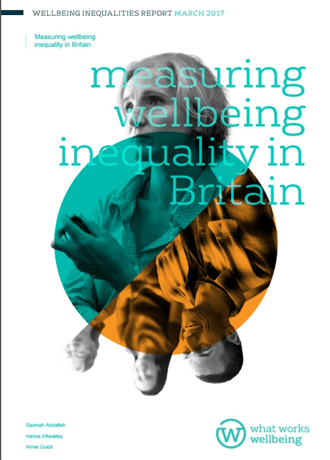Measuring Wellbeing Inequality in Britain
Downloads

Intro
This report is the first to measure wellbeing inequality, which can pinpoint those places where there is the greatest disparity between those who feel satisfied with their lives and those who do not.
Wellbeing, put simply, is about ‘how we are doing’. People tend to rate their wellbeing based on a huge range of factors, including health, education, income, relationships, crime and employment. This means that a wellbeing inequality measure provides much richer information than a more narrow focus on income inequality.
The What Works Centre for Wellbeing is working in partnership with the New Economics Foundation to explore this new approach to understanding inequality in our society.
Overview
What is wellbeing inequality? Why is it important to measure, and which parts of the United Kingdom have higher or lower levels of wellbeing inequality? This paper attempts to answer these questions. It uses the ONS Annual Population Survey to analyse wellbeing inequality in the United Kingdom. We have calculated wellbeing inequality measures for 143 local authorities between 2011 and 2015. We have also calculated wellbeing inequality for a larger number of local authorities (203 or 380) where data from three years of the survey has been pooled together, producing three-year rolling averages.
This paper also shows how these inequalities have changed over time. Additionally, it calculates a set of alternative wellbeing inequality measures, which highlights the many ways the concept can be measured.
Discussion of these alternative measures, and more details on our methodology can be found in our methods paper and the full data set can be downloaded from
the What Works Centre for Wellbeing website in Excel format for anyone to use.
Wellbeing inequality can be understood as the extent to which peoples’ experiences of life vary within a population, or between different groups.
Key findings
Important progress has been made on wellbeing and its application to policy, yet the study of inequalities in wellbeing remains largely underdeveloped. Wellbeing inequality can be understood as the extent to which peoples’ experiences of life vary within a population, or between different groups. The concept may be able to tell an interesting story about life in the UK, but questions remain about how best to measure and communicate it.
This report paper describes the findings of an initial study on wellbeing inequality in UK local authorities, with the aim of beginning a discussion about how and
why we should measure it.
The research found that:
- Looking at overall levels of wellbeing inequality in 2014-15, Blaenau Gwent and Liverpool were amongst the most unequal while Enfield and Cheshire East were amongst the most equal. Other areas with high levels of wellbeing inequality include the Welsh Valleys, Merseyside and the area around Glasgow.
- On average, in most local authorities, those with lower levels of education had lower wellbeing than those with higher education – e.g. in Blaneau Gwent and Sunderland. However, in some local authorities there was no difference at all, or those with lower levels of education actually had higher wellbeing – e.g. in Waltham Forest and the Scottish islands of Eilean Siar, Orkney & Shetland.
- The fact that some local authorities saw strong inequalities between those with differing levels of education while others saw no difference suggests that these inequalities are not inevitable and it may be that policy can help to reduce them.
Downloads
Downloads
![]()
[gravityform id=1 title=true description=true ajax=true tabindex=49]


